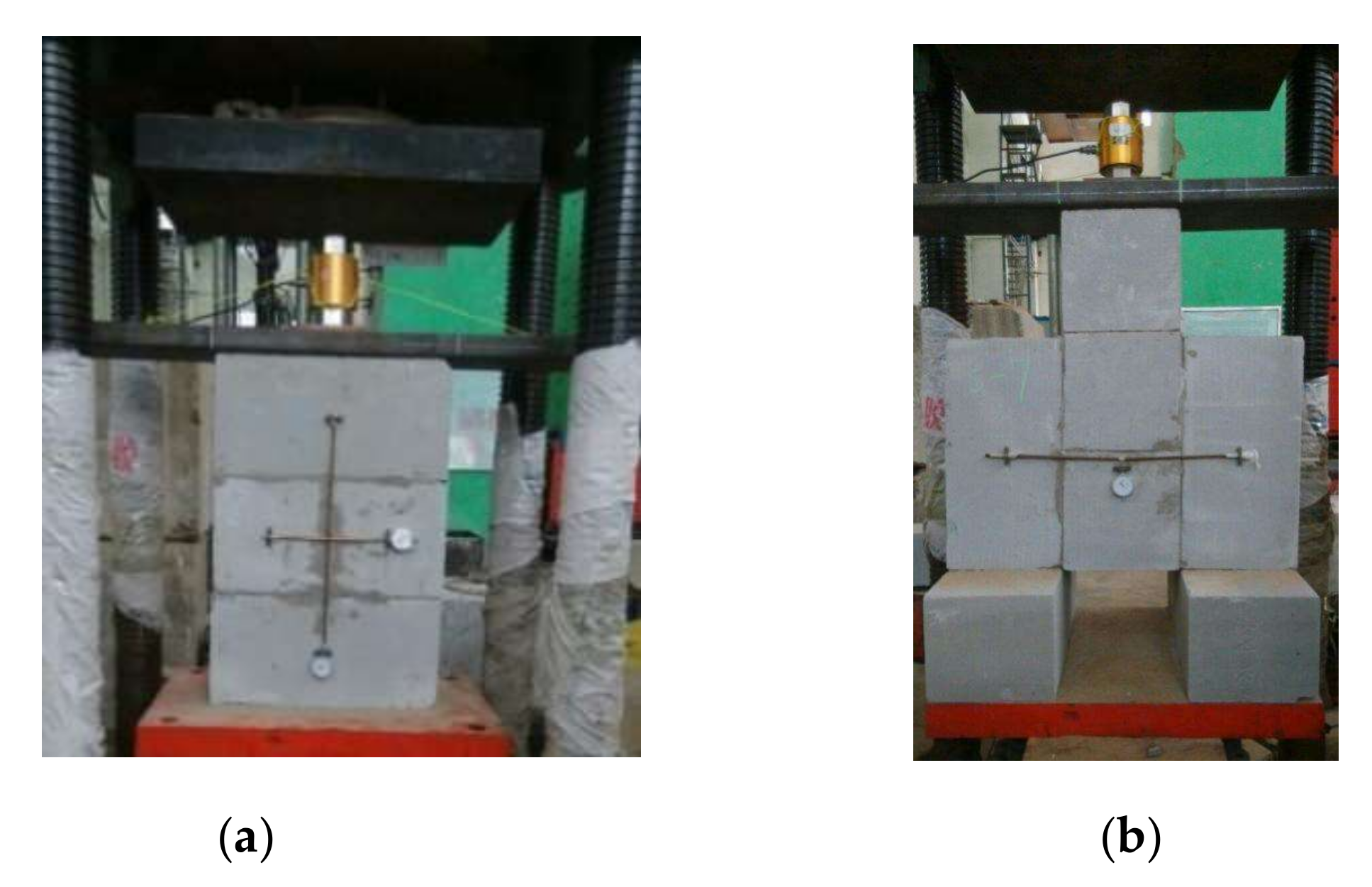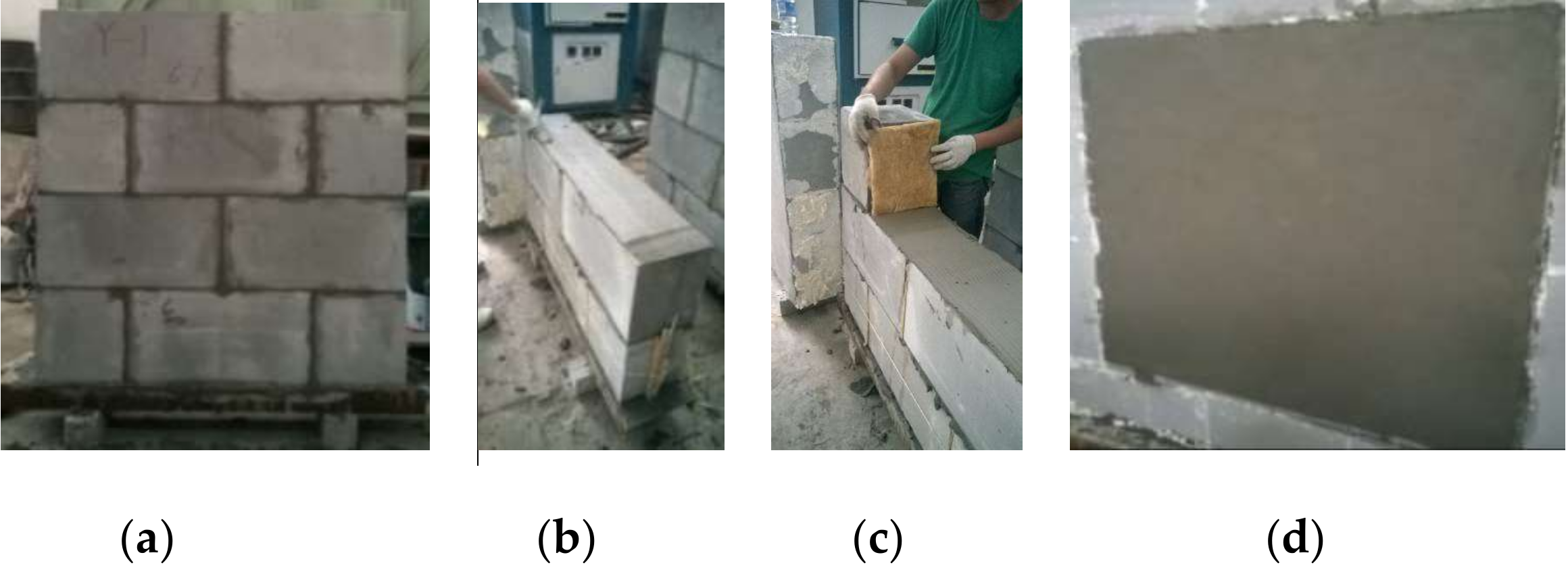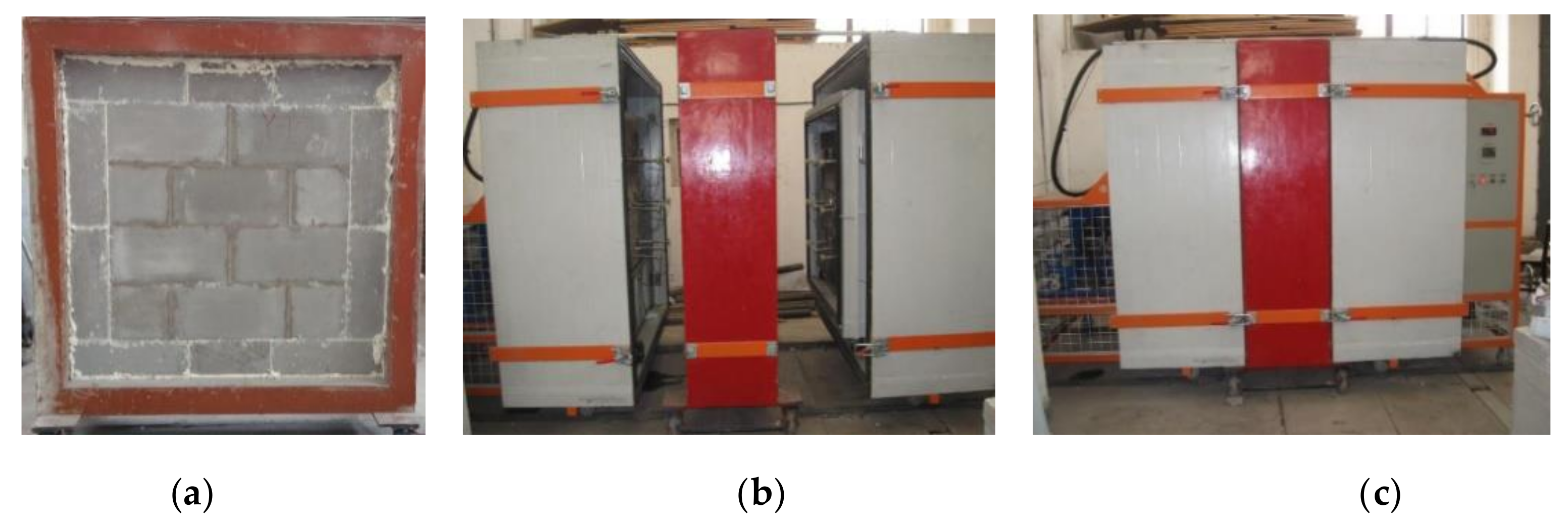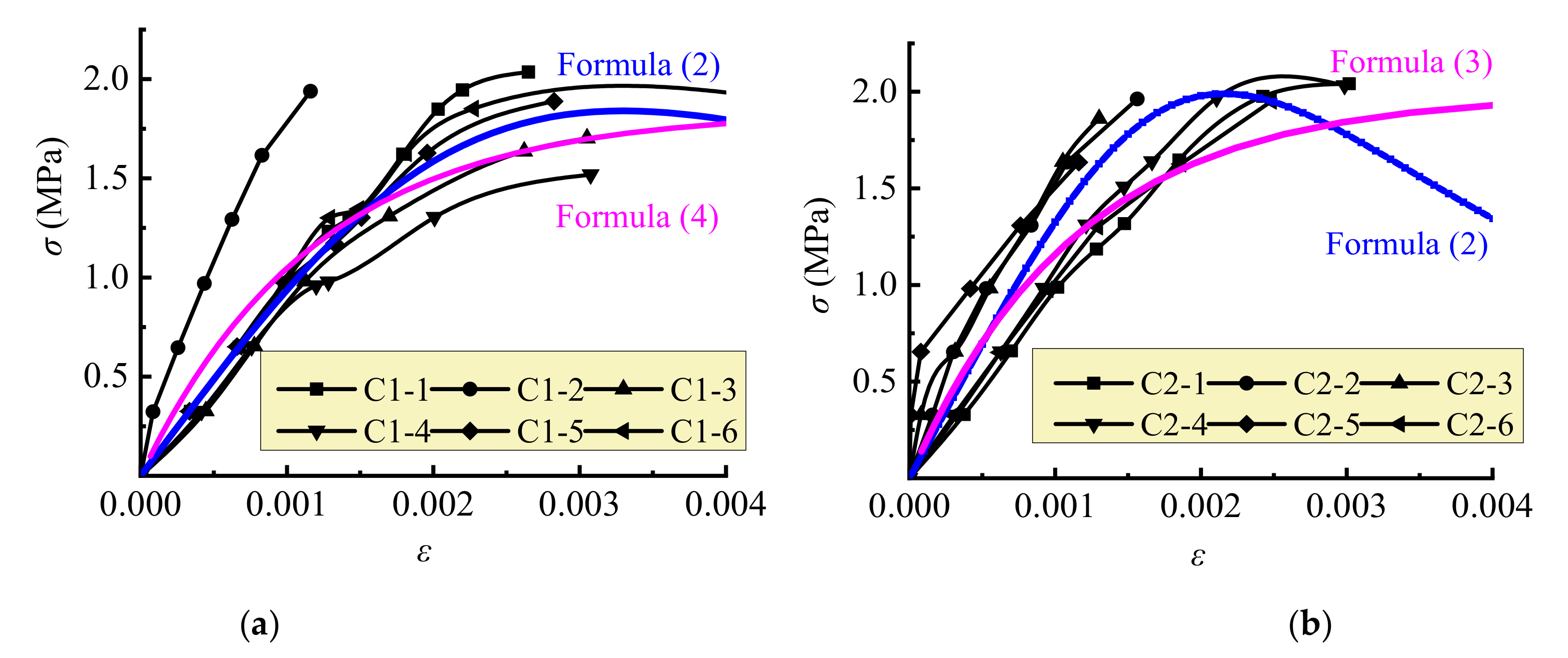Fundamental Properties and Thermal Transferability of Masonry Built by Autoclaved Aerated Concrete Self-Insulation Blocks
Abstract
1. Introduction
2. Research Significance
3. Experimental Work
3.1. Production of AAC Self-Insulation Block
3.2. Preparation of Mortars
3.3. Tests for Fundamental Properties
3.4. Tests for Thermal Transferability
4. Fundamental Properties
4.1. Fundamental Properties of AAC Block
4.2. Fundamental Properties of Mortars
4.3. Compression Performance of AAC Block Masonry
4.4. Shear Performance of AAC block Masonry
5. Thermal Transferability
5.1. Test Results
5.2. Theoretical Computed Results
5.3. Analytical Values by ANSYS
6. Discussion
6.1. Loading Capactity of Masonry
6.2. Thermal Trasfer of Masonry
6.3. Thermal Design of Masonry Walls
7. Conclusions
- (1)
- The superior products of the AAC self-insulation block were prepared with the compressive strength of 4.0 MPa and the dry density of 558 kg/m3. The AAC self-insulation block had a thermal conductivity of 0.11 W/(m·K). This is smaller than the limit of 0.16 W/(m·K) of conventional AAC block with similar strength and density.
- (2)
- Two kinds of masonry mortar and a plastering mortar were prepared for the AAC self-insulation block masonry. The fundamental properties of them were measured by experiments. The feature of the mortars is the lower thermal conductivity with expected strength. The thermal conductivity of the thin-layer mortar and the insulation mortar was 0.50 W/(m·K) and 0.19 W/(m·K), respectively. The thermal conductivity of plastering mortar was 0.48 W/(m·K).
- (3)
- The loading performances of AAC self-insulation block masonry under compression and shear along mortar joints are like that of the masonry with conventional blocks. The compressive strength of AAC self-insulation block masonry can be computed by the formula with the strengths of the block and mortar. The shear strength along mortar joints can be computed by the formula in relation with the mortar strength.
- (4)
- The heat transfer coefficient of AAC self-insulation block masonry can be determined with good agreement by the tests, the theoretical computation and the ANSYS analysis. A little deviation exists due to the difference of mortar joints including the thin-layer mortar joints, the insulation mortar joints and the horizontal mortar joints with filled vertical joints by rock wool. Therefore, the masonry can be built by any of each kind of mortar joints for the convenience of construction.
- (5)
- The heat transfer coefficient of AAC self-insulation block masonry wall with block thickness differing from 150 mm to 400 mm are proposed. Compared with the specification of China codes, the best thickness of AAC self-insulation block masonry is suggested for the outer wall of residential buildings in the severe cold zone, the cold zone and the hot summer and cold winter zone.
Author Contributions
Funding
Acknowledgments
Conflicts of Interest
References
- Narayanan, N.; Ramamurthy, K. Structure and properties of aerated concrete: A review. Cem. Concr. Compos. 2000, 22, 321–329. [Google Scholar] [CrossRef]
- Ministry of Housing and Urban-Rural Construction of the People’s Republic of China. Thermal Design Code for Civil Building; GB 50176-2016; China Building Industry Press: Beijing, China, 2016.
- Qu, X.L.; Zhao, X.G. Previous and present investigations on the components, microstructure and main properties of autoclaved aerated concrete- a review. Constr. Build. Mater. 2017, 135, 505–516. [Google Scholar] [CrossRef]
- Li, F.L.; Zhao, S.; Liang, N.; Chen, G.L. Reinforced Concrete Wall Composited with Internal Insulation Layer; China Water Power Press: Beijing, China, 2017. [Google Scholar]
- General Administration of Quality Supervision of the People’s Republic of China. Autoclaved Aerated Concrete Block; GB11968-2006; Standards Press of China: Beijing, China, 2006.
- Ministry of Housing and Urban-Rural Construction of the People’s Republic of China. Technical Specification for Application of Autoclaved Aerated Concrete; JGJ/T17-2008; China Building Industry Press: Beijing, China, 2008.
- Isu, N.; Ishida, H.; Mitsuda, T. Influence of quartz particle size on the chemical and mechanical properties of autoclaved aerated concrete (I) tobermorite formation. Cem. Concr. Res. 1995, 25, 243–248. [Google Scholar] [CrossRef]
- Isu, N.; Ishida, H.; Mitsuda, T. Influence of quartz particle size on the chemical and mechanical properties of autoclaved aerated concrete (II) fracture toughness, strength and micropore. Cem. Concr. Res. 1995, 25, 249–254. [Google Scholar] [CrossRef]
- Ramamurthy, K.; Narayanan, N. Influence of composition and curing on drying shrinkage of aerated concrete. Mater. Struct. 2000, 33, 243–250. [Google Scholar] [CrossRef]
- Garbalinska, H.; Stasiak, M.; Bochenek, M. Assessment of a new method for determining the relationship between effective diffusivity and moisture concentration-exemplified by autoclaved aerated concrete of four density classes. Intern. J. Heat Mass Transf. 2018, 124, 288–297. [Google Scholar] [CrossRef]
- He, X.; Yin, J.; Yang, J.W.; Liang, Q.; Wu, S.Y. Effect of dry-wet circulation on the mechanical properties and pore structure of autoclaved aerated concrete. Mater. Tech. 2019, 2, 177–182. [Google Scholar] [CrossRef]
- Alexanderson, J. Relations between structure and mechanical properties of autoclaved aerated concrete. Cem. Concr. Res. 1991, 21, 655–662. [Google Scholar] [CrossRef]
- Zhou, C.Y.; Wei, J.X.; Yu, Q.J. Water absorption characteristics of autoclaved aerated concrete. J. Wuhan Univ. Tech. 2007, 4, 22–26. [Google Scholar]
- Jerman, M.; Keppert, M.; Výborný, J.; Robert, Č. Hygric, thermal and durability properties of autoclaved aerated concrete. Constr. Build. Mater. 2013, 41, 352–359. [Google Scholar] [CrossRef]
- Yao, X.L.; Yi, S.Y.; Fan, L.W. Effective thermal conductivity of moist aerated concrete with different porosities. J. Zhejiang Univ. (Eng. Sci.) 2015, 49, 1101–1107. [Google Scholar]
- Wongkeo, W.; Thongsanitgrrn, P.; Pimraksa, K.; Chaipanich, A. Compressive strength, flexural strength and thermal conductivity of autoclaved concrete block made using bottom ash as cement replacement materials. Mater. Des. 2012, 35, 434–439. [Google Scholar] [CrossRef]
- Wang, C.L.; Ni, W.; Zhang, S.Q.; Wang, S.; Gai, G.S.; Wang, W.K. Preparation and properties of autoclaved aerated concrete using coal gauge and iron ore tailings. Constr. Build. Mater. 2016, 104, 109–115. [Google Scholar] [CrossRef]
- Huang, X.Y.; Ni, W.; Cui, W.H.; Wang, Z.J.; Zhu, L.P. Preparation of autoclaved aerated concrete using copper tailings and blast furnace slag. Constr. Build. Mater. 2012, 27, 1–5. [Google Scholar] [CrossRef]
- Cai, L.X.; Ma, B.G.; Li, X.G.; Lv, Y.; Liu, Z.L.; Jian, S.W. Mechanical and hydration characteristics of autoclaved aerated concrete (AAC) containing iron-tailings: Effect of content and fineness. Constr. Build. Mater. 2016, 128, 361–372. [Google Scholar] [CrossRef]
- Kunchariyakun, K.; Asavapisit, S.; Sombatsompop, K. Properties of autoclaved aerated concrete incorporating rice husk ash as partial replacement for fine aggregate. Cem. Concr. Compos. 2015, 55, 11–16. [Google Scholar] [CrossRef]
- He, T.S.; Xu, R.S.; Da, Y.Q.; Yang, R.H.; Chen, C.; Liu, Y. Experimental study of high-performance autoclaved aerated concrete produced with recycled wood fibre and rubber powder. J. Clean. Product. 2019, 234, 559–567. [Google Scholar] [CrossRef]
- Pehlivanli, Z.O.; Uzun, İ.; Yücel, Z.P.; Demir, İ. The effect of different fiber reinforcement on the thermal and mechanical properties of autoclaved aerated concrete. Constr. Build. Mater. 2016, 112, 325–330. [Google Scholar] [CrossRef]
- Ministry of Housing and Urban-Rural Construction of the People’s Republic of China. Design Standard for Energy Efficiency of Residential Buildings in Severe Cold and Cold Zones; JGJ26-2018; China Building Industry Press: Beijing, China, 2018.
- Ministry of Housing and Urban-Rural Construction of the People’s Republic of China. Design Standard for Energy Efficiency of Residential Buildings in Hot Summer and Cold Winter Zone; JGJ134-2010; China Building Industry Press: Beijing, China, 2010.
- Thongtha, A.; Khongthon, A.; Boonsri, T.; Hoy-Yen, C. Thermal effectiveness enhancement of autoclaved aerated concrete wall with PCM-contained conical holes to reduce the cooling load. Materials 2019, 12, 2170. [Google Scholar] [CrossRef]
- Punlek, C.; Maneewan, S.; Thongtha, A. Phase change material coating on autoclaved aerated lightweight concrete for cooling load reduction. Mater. Sci. 2017, 23, 145–149. [Google Scholar] [CrossRef]
- Zheng, M.Y.; Ma, J.Y. Research of the mortar effect on the energy consumption of walls. J. Harbin Architec. Civ. Eng. Inst. 1994, 27, 58–63. [Google Scholar]
- Jasiński, R. Research on the influence of bed joint reinforcement on strength and deformability of masonry shear walls. Materials 2019, 12, 2543. [Google Scholar] [CrossRef] [PubMed]
- Raj, A.; Borsaikia, A.C.; Dixit, U.S. Bond strength of autoclaved aerated concrete (AAC) masonry using various joint materials. J. Build. Eng. 2020, 28, 101039. [Google Scholar] [CrossRef]
- Liu, X.J.; Tang, T. Research in basic thermal conductivity of insulation mortar and ordinary mortar. J. Hunan Inst. Eng. 2013, 23, 84–86. [Google Scholar]
- Si, Z.K.; Zhang, D.L.; Chen, X.F. Experimental study on thin layer mortar formulation for self-insulation system. China Concr. Cem. Products 2016, 43, 61–65. [Google Scholar]
- Ministry of Housing and Urban-Rural Construction of the People’s Republic of China. Code for Design of Masonry Structures; GB50003-2011; China Building Industry Press: Beijing, China, 2011.
- Avadhoot, B.; Nikhil, P.Z.; Robin, D.; Pradip, S. Experimental investigation of autoclaved aerated concrete masonry. J. Mater. Civ. Eng. 2019, 7, 04019109. [Google Scholar]
- Jasiński, R.; Drobiec, Ł.; Mazur, W. Validation of selected non-destructive methods for determining the compressive strength of masonry units made of autoclaved aerated concrete. Materials 2019, 12, 389. [Google Scholar] [CrossRef]
- Gao, J.P.; Lei, L.; Wu, Y.B.; Xiong, Y.J. Experiment and analysis on load bearing of thermal insulation composite wall. J. Hunan Inst. Eng. 2014, 4, 87–90. [Google Scholar]
- Artino, A.; Evola, G.; Margani, G.; Marino, E.M. Seismic and energy retrofit of apartment buildings through autoclaved aerated concrete (AAC) blocks infill walls. Sustainability 2019, 11, 3939. [Google Scholar] [CrossRef]
- Madan, A.; Reinborn, A.M. Modeling of masonry infill panels for structural analysis. Concrete 1997, 12, 1295–1302. [Google Scholar] [CrossRef]
- She, W.; Xie, D.; Jones, M.R. Numerical analysis of the thermal behaviors of cellular concrete in two and three dimensional models. Comput. Concr. 2016, 18, 319–336. [Google Scholar] [CrossRef]
- General Administration of Quality Supervision of the People’s Republic of China. Test Methods of Autoclaved Aerated Concrete; GB11969-2008; Standards Press of China: Beijing, China, 2008.
- Ministry of Housing and Urban-Rural Construction of the People’s Republic of China. Test Method for Basic Properties of Building Mortar; JGJ/T70-2009; China Building Industry Press: Beijing, China, 2009.
- Ministry of Housing and Urban-Rural Construction of the People’s Republic of China. Standard for Test Method of Basic Mechanical Properties of Masonry; GB/T50129-2011; China Building Industry Press: Beijing, China, 2011.
- General Administration of Quality Supervision of the People’s Republic of China. Thermal Insulation- Determination of Steady-state Thermal Resistance and Related Properties—Heat Flow Meter Apparatus; GB10295-2008; ISO8301:1991; Standards Press of China: Beijing, China, 2008.
- Lu, M.J.; Yang, S.; Feng, X.Z.; Zhao, S.B. Experimental study on thermal conductivity of concrete for building reinforced concrete composite wall. Appl. Mechan. Mater. 2013, 438, 329–332. [Google Scholar] [CrossRef]
- Campanale, M.; Deganello, M.; Moro, L. Effect of moisture movement on tested thermal conductivity of moist aerated autoclaved concrete. Transp. Porous Med. 2013, 98, 125–146. [Google Scholar] [CrossRef]
- General Administration of Quality Supervision of the People’s Republic of China. Thermal Insulation Determination of Steady-State Thermal Resistance and Related Properties—Guarded Hot Plate Apparatus; GB/T 10294-2008; ISO8302:1991; Standards Press of China: Beijing, China, 2008.
- Zhao, S.; Li, F.L.; Yang, S.; Song, L.S. Thermal insulation behavior of reinforced concrete composite wall with internal insulating layer. Adv. Mater. Res. 2011, 152–153, 395–398. [Google Scholar]
- Mander, J.B.; Priestley, M.J.N.; Park, R. Therotical stress-strain behavior of confined concrete. J. Struct. Div. ASCE 1988, 8, 1827–1849. [Google Scholar] [CrossRef]
- Reinborn, A.M.; Madan, A.; Valles, R.E.; Reichamnn, Y.; Mander, J.B. Modelling of Masonry Infill Panels for Structural Analysis; Tchnical Report NCEER-95-0018; State University of New York at Buffalo: Buffalo, NY, USA, 1995. [Google Scholar]
- Zhao, S.B.; Yang, S.; Song, L.S.; Sun, L.; Song, C.X. Experimental study on thermal insulation properties of reinforced concrete composite wall. Appl. Mechan. Mater. 2011, 99–100, 676–679. [Google Scholar] [CrossRef]
- Jin, H.Q.; Yao, X.L.; Fan, L.W. Experimental determination and fractal modeling of the effective thermal conductivity of autoclaved aerated concrete: Effects of moisture content. Intern. J. Heat Mass Transf. 2016, 92, 589–602. [Google Scholar] [CrossRef]








| Group of Specimens | Wall Size (mm) | Mortar Joint (mm) | Plastering Thickness | |||
|---|---|---|---|---|---|---|
| Length | Height | Width | Horizontal | Vertical | ||
| M1 | 1205 | 1215 | 250 | 5 | 5 | No |
| M1P | 1205 | 1215 | 260 | 5 | 5 | 5 |
| M2 | 1210 | 1230 | 250 | 10 | 10 | No |
| M2P | 1210 | 1230 | 270 | 10 | 10 | 10 |
| M3 | 1205 | 1215 | 250 | 5 | Rock wool | No |
| M3P | 1205 | 1215 | 260 | 5 | Rock wool | 5 |
| Specimen | Group 1 | Group 2 | Group 3 |
|---|---|---|---|
| Dry density (kg/m3) | 558 | 555 | 560 |
| Moisture content (%) | 1.43 | 1.07 | 1.33 |
| Water absorption (%) | 63.5 | - | - |
| Cubic compressive strength (MPa) | 3.9 | 4.1 | 4.1 |
| Item | Thin-Layer Mortar | Insulation Mortar | Plastering Mortar |
|---|---|---|---|
| Dry density (kg/m3) | 855 | 782 | 850 |
| Segregation degree (mm) | 10 | 12 | 9 |
| Compressive strength (MPa) | 13..6 | 12.0 | 9.3 |
| Bond strength (MPa) | 1.0 | 0.75 | 0.89 |
| Setting time (h) | 3.8 | 4.4 | 3.8 |
| Freeze-thaw resistance after 25 cycles | Mass loss 2.9% Strength loss 12% | Mass loss 3.6% Strength loss 10% | Mass loss 2.5% Strength loss 11% |
| Linear shrinkage (mm/m) | 0.70 | 0.90 | 0.65 |
| Thermal conductivity [W/(m·K)] | 0.50 | 0.19 | 0.48 |
| Specimen | f1 (MPa) | f2 (MPa) | fc,i (MPa) | E (MPa) | ν | ε0 | Mortar Joint |
|---|---|---|---|---|---|---|---|
| C1-1~C1-3 | 4.1 | 12.0 | 1.91 | 1021 | 0.158 | 0.00269 | Insulation mortar with thickness of 10 mm |
| C1-4~C1-6 | 4.1 | 12.0 | 1.77 | 944 | 0.212 | 0.00398 | |
| C2-1~C2-3 | 4.1 | 13.6 | 2.01 | 1628 | 0.243 | 0.00178 | Thin-layer mortar with thickness of 5 mm |
| C2-4~C2-6 | 4.1 | 13.6 | 1.98 | 1925 | 0.157 | 0.00221 |
| Specimen | f1 (MPa) | f2 (MPa) | fv,m (MPa) | Mortar Joint |
|---|---|---|---|---|
| S1-1~S1-3 | 4.1 | 12.0 | 0.390 | Insulation mortar with thickness of 10 mm |
| S1-4~S1-6 | 4.1 | 12.0 | 0.343 | |
| S2-1~S2-3 | 4.1 | 13.6 | 0.280 | Thin-layer mortar with thickness of 5 mm |
| S2-4~S2-6 | 4.1 | 13.6 | 0.370 |
| Group of Specimens | Measured Surface Thermal Resistance (m2·K/W) | Heat Transfer Coefficient [W/(m2·K)] | |||
|---|---|---|---|---|---|
| Hot Side | Cold Side | Tested Value | Theoretical Computed | ANSYS Analytical | |
| M1 | 0.091 | 0.006 | 0.559 | 0.523 | 0.555 |
| M1P | 0.105 | 0.001 | 0.509 | 0.518 | 0.549 |
| M2 | 0.096 | 0.006 | 0.561 | 0.505 | 0.548 |
| M2P | 0.087 | 0.012 | 0.533 | 0.497 | 0.529 |
| M3 | 0.094 | 0.001 | 0.555 | 0.493 | 0.541 |
| M3P | 0.097 | 0.008 | 0.536 | 0.489 | 0.536 |
| Environment | Storeys of Building | Block Thickness (mm) | 400 | 360 | 300 | 250 | 200 | 180 | 150 |
|---|---|---|---|---|---|---|---|---|---|
| K0 [W/(m2·K)] | 0.35 | 0.40 | 0.48 | 0.55 | 0.66 | 0.72 | 0.84 | ||
| Severe cold zone A | ≤3 | K0 ≤ 0.25 | × | × | × | × | × | × | × |
| 4–8 | K0 ≤ 0.40 | √ | best | × | × | × | × | × | |
| ≥9 | K0 ≤ 0.50 | √ | √ | best | × | × | × | × | |
| Severe cold zone B | ≤3 | K0 ≤ 0.30 | × | × | × | × | × | × | × |
| 4–8 | K0 ≤ 0.45 | √ | best | × | × | × | × | × | |
| ≥9 | K0 ≤ 0.55 | √ | √ | √ | best | × | × | × | |
| Severe cold zone C | ≤3 | K0 ≤ 0.35 | √ | × | × | × | × | × | × |
| 4–8 | K0 ≤ 0.50 | √ | √ | best | × | × | × | × | |
| ≥9 | K0 ≤ 0.60 | √ | √ | √ | best | × | × | × | |
| Cold zone | ≤3 | K0 ≤ 0.45 | √ | best | × | × | × | × | × |
| 4–8 | K0 ≤ 0.60 | √ | √ | √ | best | × | × | × | |
| ≥ 9 | K0 ≤ 0.70 | √ | √ | √ | √ | best | × | × | |
| Hot summer and cold winter zone | all | K0 ≤ 1.0 | √ | √ | √ | √ | √ | √ | best |
© 2020 by the authors. Licensee MDPI, Basel, Switzerland. This article is an open access article distributed under the terms and conditions of the Creative Commons Attribution (CC BY) license (http://creativecommons.org/licenses/by/4.0/).
Share and Cite
Li, F.; Chen, G.; Zhang, Y.; Hao, Y.; Si, Z. Fundamental Properties and Thermal Transferability of Masonry Built by Autoclaved Aerated Concrete Self-Insulation Blocks. Materials 2020, 13, 1680. https://doi.org/10.3390/ma13071680
Li F, Chen G, Zhang Y, Hao Y, Si Z. Fundamental Properties and Thermal Transferability of Masonry Built by Autoclaved Aerated Concrete Self-Insulation Blocks. Materials. 2020; 13(7):1680. https://doi.org/10.3390/ma13071680
Chicago/Turabian StyleLi, Fenglan, Gonglian Chen, Yunyun Zhang, Yongchang Hao, and Zhengkai Si. 2020. "Fundamental Properties and Thermal Transferability of Masonry Built by Autoclaved Aerated Concrete Self-Insulation Blocks" Materials 13, no. 7: 1680. https://doi.org/10.3390/ma13071680
APA StyleLi, F., Chen, G., Zhang, Y., Hao, Y., & Si, Z. (2020). Fundamental Properties and Thermal Transferability of Masonry Built by Autoclaved Aerated Concrete Self-Insulation Blocks. Materials, 13(7), 1680. https://doi.org/10.3390/ma13071680





